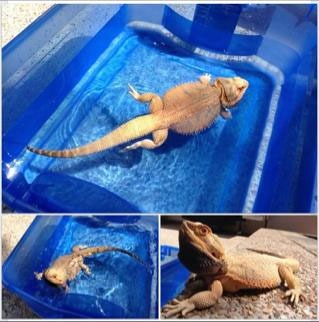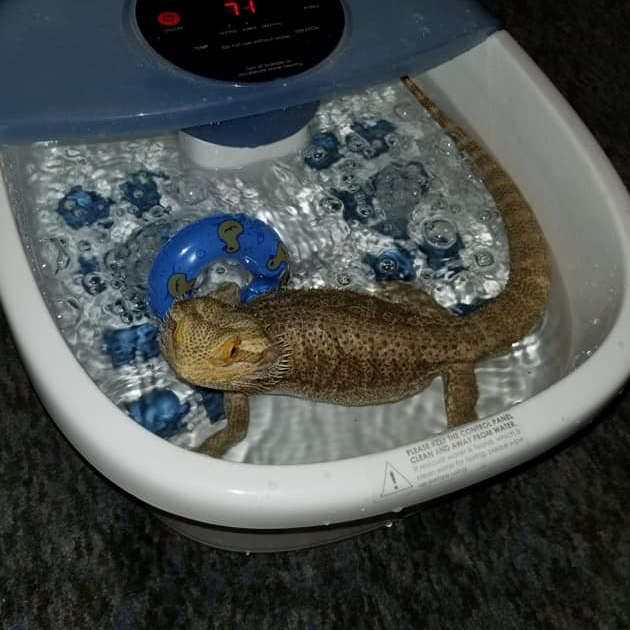Can Bearded Dragons Swim?
Bearded dragons swim surprisingly well for creatures that couldn’t look less like they belong in water. There are different opportunities for swimming including a container, bathtub, pond or even a puddle.
Creating opportunities for swimming activity can provide environmental stimulation and fun. A swim gym is especially set up to provide exactly that.

Jump To…
Setting up a Swim Gym
A swim gym can be made using a large container or even a bathtub. If the bath has a gentle and quiet jet stream function (some have spa functionality) then even better.
Fill the bath or container with water deep enough that the bearded dragon can swim. The water should be at least tepid or heading towards the lukewarm side. Scatter some rocks, branches or other objects in the water to create little islands. If there is a gentle jet available, turn it on. That’s is all there is to a swim gym.
A small pond right near a sunny spot may also be ideal. All that needs to be added is a few objects that make it easy to get out of the water as the bearded dragon chooses.
5 Reasons to Give a Bearded Dragon a Swim Gym
Here are 5 reasons to give your bearded dragon a swim gym:
- Can aid in shedding
- Environmental stimulation
- Activity and exercise
- Hydration
- Water encourages bowel movements
Melbourne Zoo’s Reptile Swim Gym
Melbourne Zoo has created a reptile swim gym. The swim gym water is filtered and temperature controlled with a current to give more stimulation. The reptiles may swim with or against the current as they choose.
A platform is provided in the water such as a pipe or rock that the reptile can pop onto if it has had enough.
Reptiles are given up to 5 minutes of swimming activity unless they tire before hand in.
Do Bearded Dragons Like to Swim?
Some bearded dragons like to swim, but not all. When bearded dragons swim they can, and often do, inflate themselves with air to help themselves float.
Even though bearded dragons do have some floating ability, they seem to enjoy swimming most when they can do it in short bursts. This makes sense since it isn’t a talent they are known for using in the wild so it can be understandable that swimming may feel uncomfortable and stressful if not introduced and managed well.
Creating a swim gym is easy and allows a bearded dragon to swim from one object to another when it is ready. This is easily catered for by placing branches, rocks and other objects in the water as discussed in the reptile swim gym. These objects become islands, ever ready for the moment your bearded dragon needs a rest.
The water temperature can tepid or lukewarm water in warm environments. It is best to avoid swimming activities in cold environment even in a well set up gym as the bearded dragons body will cool will cool quickly when resting on an island.
Providing shallow water is another way to offer some swimming time without too much stress, although they don’t quite get to swim as such. Ensuring the water is at a level where your bearded dragon can touch the bottom without having its head underwater will likely give it more confidence.
Can Bearded Dragons Swim in Cold Water?
Bearded dragons should not swim in cold water, they are ectotherms. This means that they are dependent on the environment for heat. Cold environments slow reptiles down and the colder it gets the less they can move. This could become quite disastrous when swimming.
If it is a hot day and there is some water in or very near the sun that is easily accessible then bearded dragons swimming in cool (unheated) water should not present an issue. Otherwise, it is best bearded dragons do not swim in cold water, especially if they have eaten within the last couple of hours. If the water is cold, limit the exposure to prevent their body temperature cooling down and provide some time in warm sunlight immediately afterwards.
Can Bearded Dragons Swim in Tap Water?
For amphibians tap water is a no go, however bearded dragons may swim in tap water. There is no scientific research available at this stage that indicates the effects or tolerance of bearded dragons to tap water.
It is a common practice by many bearded dragon owners to provide tap water for their pets to swim in and drink with no reported harm. Of course, be conscious that each country, even different regions, will have different levels of chemicals in the water.
💦💦Fred absolutely loving life right now 💦💦🌞🌡🌞 – Vickie
Posted by Bearded Dragons World on Wednesday, July 4, 2018
Can Bearded Dragons Swim in a Pool?
As with tap water, there is nothing to say that bearded dragons can’t swim in a pool however pools are far more heavily chlorinated than tap water.
The purpose of putting chlorine in pools is to disinfect the water, prevent bacterial growth. Not something bearded dragons need to be exposed to. In humans heavily chlorinated pools can cause irritation of the eyes, and stripping the skin and hair of oils leaving them feel dry.
Outside of possible drying of a bearded dragon’s skin there is also the potential for them to drink the water. Lightly chlorinated water may not cause a problem however it is not ideal regardless of the level. Strongly recommend avoiding pools.
In addition, pools are a large body of water for an animal not known for its swimming in the wild. Swimming in a pool may well cause undue stress. Stress levels are not always obvious in behaviours to humans and they have limited communication.

Can Baby Bearded Dragons Swim?
Baby bearded dragons can swim as well as adults. Provide lots of branches and rocks to build confidence and the feeling of security. What age a bearded dragon swims at is not as relevant as what it swims in. A swim gym is ideal for baby bearded dragons to swim in all the way to adults.
Bearded Dragons Swim: Conclusion
Bearded dragons swim well however whether they enjoy it will be down to the individual.
Introduce a bearded dragon to swimming using a container with shallow lukewarm water. Keep the water level to where they can touch the bottom while keeping their heads above water. Provide an object that creates an island to get them used to being able to pop in and out of the water in their own time.
Bearded dragons can enjoy swimming in small ponds that have rocks, branches and other objects to climb onto. Feeling secure in having places they can seek refuge on will likely provide confidence so your bearded dragon can swim and stop as it chooses.
If your bearded dragon does not seem to enjoy swimming, then cease the activity. While there are benefits stress negates benefits and they can all be provided by other means.
Bearded dragons may take in some water while swimming which is useful for hydration. Swimming will often help bearded dragons with constipation or simply moving their bowels.
Never leave a bearded dragon unattended when swimming.

Further Information
- Health Line. Chlorine Poisoning
- Live Science. Stacy Sampson. Aug 16, 2017. Yasemin Saplakoglu. June 12, 2018. What Does Chlorine Really Do to Your Body?
- Pet Poison Helpline. Wildlife and Exotics Poisoning Concerns





